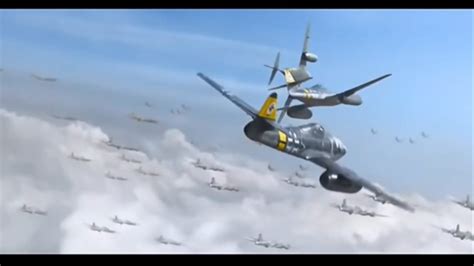
Introduction: The Clash of Aviation Titans - Me 262 vs. P-51
During the final stages of World War II, two exceptional aircraft emerged as symbols of technological advancement and aerial prowess: the German Me 262 and the American P-51 Mustang. These warbirds represented the pinnacle of fighter aircraft design, embodying speed, agility, and firepower. As they took to the skies, they engaged in thrilling duels that shaped the course of aerial combat and left an indelible mark on aviation history.
Design and Innovation: Pushing the Boundaries of Flight
The Me 262, conceived by the brilliant German engineer Willy Messerschmitt, was a revolutionary aircraft that broke away from conventional design norms. Its sleek fuselage, swept-back wings, and tricycle landing gear hinted at its cutting-edge nature. Powered by two Junkers Jumo 004 turbojet engines, the Me 262 could achieve speeds that surpassed 540 mph, making it the world's first operational jet fighter. In contrast, the P-51 Mustang, designed by North American Aviation, adhered to a more conventional approach. Its sleek laminar-flow wing and powerful Packard V-1650-7 engine provided exceptional speed and maneuverability. However, the Mustang's true strength lay in its versatility, serving as both a long-range escort fighter and a deadly air-to-ground attacker.
Armament and Firepower: Unleashing a Symphony of Destruction
Both the Me 262 and the P-51 packed a formidable arsenal, each tailored to its unique combat role. The Me 262 bristled with four MK 108 30mm cannons, capable of inflicting devastating damage with their high-velocity rounds. The cannons were mounted in the aircraft's nose, allowing for precise aiming and concentrated firepower. The P-51, on the other hand, relied on six .50 caliber machine guns, mounted in the wings. While not as powerful as the Me 262's cannons, the machine guns offered a higher rate of fire, creating a lethal stream of bullets that could shred enemy aircraft.
Performance and Handling: A Dance of Precision and Agility
The Me 262 possessed blistering speed, outclassing its piston-engine counterparts. Its jet engines propelled it to dizzying heights, allowing it to escape danger zones and dictate the terms of engagement. However, the aircraft's high-speed handling characteristics were demanding, requiring exceptional skill from its pilots. The P-51, while not as fast as the Me 262, excelled in maneuverability and agility. Its responsive controls and light weight enabled it to outmaneuver the Me 262 in close-quarters combat, turning the tables on its faster opponent.
The Duel in the Skies: A Battle of Wits and Courage
The Me 262 and the P-51 engaged in numerous aerial duels, testing the limits of their capabilities and the resolve of their pilots. German ace Erich Hartmann, with his tally of 352 aerial victories, famously encountered a squadron of P-51s over Germany. Despite the numerical disadvantage, Hartmann's superior skill and the Me 262's speed advantage allowed him to evade and outmaneuver his pursuers, escaping unscathed. In another notable encounter, American pilot Chuck Yeager, flying a P-51, intercepted a Me 262 piloted by German ace Heinz Bär. Yeager's quick thinking and aggressive maneuvers allowed him to gain an advantage, ultimately shooting down Bär's aircraft.
Impact on Aerial Combat: A Legacy of Innovation and Inspiration
The Me 262 and the P-51 left an indelible mark on aerial combat, shaping the trajectory of fighter aircraft development for years to come. The Me 262's jet propulsion technology became the standard for future military aircraft, ushering in a new era of high-speed aerial warfare. The P-51's versatility and adaptability inspired the design of subsequent generations of fighter aircraft, demonstrating the importance of maneuverability and firepower in aerial combat.
Conclusion: A Symphony of Aviation Excellence
The Me 262 and the P-51 Mustang stand as testaments to human ingenuity, innovation, and the relentless pursuit of aviation excellence. Their duels in the skies during World War II showcased the pinnacle of fighter aircraft design and the extraordinary skill of the pilots who flew them. As we reflect on their legacy, we are reminded of the transformative power of technology and the enduring spirit of human endeavor that continues to drive aviation forward.